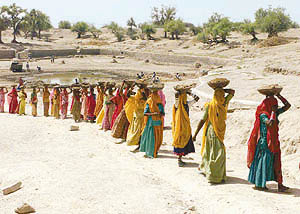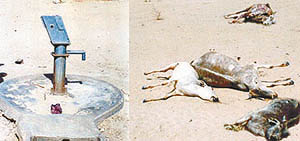| |
 The
word famine is not new to farmers of this region. The
state faced it recently in 1979 and 1987. With every
passing year, the situation is getting grimmer. Experts
say on an average, ground water is being exploited by 30
per cent more than the normal threshold value.
Hydro-geologists from the Ground Water Board opine that
Punjab might become a desert by 2025, if the ground
water-table is exploited in such a rampant fashion. The
word famine is not new to farmers of this region. The
state faced it recently in 1979 and 1987. With every
passing year, the situation is getting grimmer. Experts
say on an average, ground water is being exploited by 30
per cent more than the normal threshold value.
Hydro-geologists from the Ground Water Board opine that
Punjab might become a desert by 2025, if the ground
water-table is exploited in such a rampant fashion.Reckless installation of
tubewells by the private and government agencies,
incentive to farmers in the form of free power, discharge
of effluents by industrial houses, faulty cropping
pattern, lack of will to harness rainwater and above all,
empty government coffers — each factor is working
towards hammering in the ground-water table.
Already, the Punjab
Government has spent more than Rs 10 crore to set up
1,600 deep tubewells. In addition there are, a large
number of shallow tubewells installed by private
agencies.
While on the one hand
there is a problem of depleting water table in the areas
with potable water, on the other hand there is a rise in
the water table in waterlogged areas. Water is brackish
and unfit for human consumption at that place.
Consequently, water has
been over-exploited in 73 of the 138 blocks in the state
and 11 others are in the critical dark zone stage. A high
fluoride content has been observed in the samples
collected from the Jalandhar and Amritsar areas and
waterlogging is a perpetual problem in Ferozepore and
Bathinda districts. More than 6,50,000 hectares of good
agricultural land has been affected by salinity and
alkalinity. Are these portents of a famine in the near
future?
Sadly yes! The writing
on the wall is ominous. If corrective measures are not
taken up imperatively, the granary of the nation might be
standing on a crop of carcass.
 Though the state has an agro-based
economy, it houses quite a few industrial establishments
as well. These industrial units discharge pollutants into
the groundwater and in the rivers. This can result in
eutrophication of water bodies due to inorganic nitrates
and phosphates. "Water samples collected from some
sites in Ludhiana had chromium and cyanide contents at
12.9 and 2 mg per litre, respectively, while the
permissible limit should not exceed .05 mg/litre. This is
shocking," says Ajit Singh Saini, a chemical
analyst. Though the state has an agro-based
economy, it houses quite a few industrial establishments
as well. These industrial units discharge pollutants into
the groundwater and in the rivers. This can result in
eutrophication of water bodies due to inorganic nitrates
and phosphates. "Water samples collected from some
sites in Ludhiana had chromium and cyanide contents at
12.9 and 2 mg per litre, respectively, while the
permissible limit should not exceed .05 mg/litre. This is
shocking," says Ajit Singh Saini, a chemical
analyst.
The water table in
Punjab is falling by 0.20 m per year. Most of the 35
blocks of the white zone category, that is areas where
the percentage of groundwater development is less than
65, fall in the south western part of Punjab — an
area where water cannot be tapped even otherwise, because
of its brackish nature.
The situation in Haryana
is no better. Of the 108 blocks in the state, the water
table declined in 48 and the water level declined by a
whopping 17 metres in the Nangal Chaudhry block. As per a
study conducted by the groundwater cell of the Department
of Agriculture, Haryana, the water level declined in the
Gurgaon, Karnal, Kurukshetra, Panchkula, Mahendergarh and
Rewari districts largely due to the rampant installation
of tubewells.
In the 300-km-long and
about 30-km-wide Kandi area, which more or less marks the
boundary of the Shivalik range, the water level
fluctuation is immense. The water table went down by more
than 7 metres in Balachaur, Nawanshahr district, between
1995 and 1996. The recharge is merely 20 to 50 per cent
of extraction in Hoshiarpur and Gurdaspur districts,
which means that even the rainwater is not able to
compensate the extraction.
Some drastic corrective
measures need to be taken up. The percentage of area
irrigated by tubewells increased to about 60 per cent in
1998 from 23 per cent in 1958. "Free power is
affecting the groundwater table in Punjab. Since farmers
do not have to pay, pumps keep running idle, thereby
wasting water. Canal irrigation should supplement
tubewell irrigation wherever possible," says Gopal
Kishan, a professor in geography.
Nearly 75 per cent of
the cultivated land in Punjab is under water-intensive
cropping pattern of wheat and rice. Farmers need to be
told about the effects of over withdrawal of water.
"Early transplantation of paddy should be
discouraged and peasants should be educated about the
benefits of other cropping patterns. Rooftop water
harvesting should be encouraged. Himachal Pradesh has
already made it mandatory in Hamirpur, where roof-tops
have to have a gradient so that rainwater can be
harnessed," says S.P. Mittal, a principal scientist
in the Indian Council of Agricultural Research.
The Union Minister for
Urban Development, Jagmohan recently indicated in New
Delhi that rooftop-water harvesting would be incorporated
in building by-laws, while the Human Settlement
Technology for the conservation of rainwater has been
finalised by the Indian Institute of Technology. However,
some of the technocrats are apprehensive about the
results of rooftop water harvesting.
However, the farmers are
unwilling to shift to other cropping patterns. "Even
if we shift to non-foodgrain crops, which require less
water, like sunflower, there is no proper procurement
infrastructure laid down by the government," says
Bhupinder Singh, a farmer from Akalgarh, in Ludhiana
district. Experts agree: "The government should
leave a few things for private investors. Let them create
an infrastructure for non-foodgrain crops," they
say.
In the Kandi area, more
than 40 per cent of the rainwater is lost as surface
run-off. There are more than 21 choes in
Hoshiarpur, four in Ropar and one in Gurdaspur district.
Discharge in these is the heaviest during the rainy
season and the least in June. The Chak Saddu choe,
for example, discharges 0.25 cusecs of water in June, a
dry month. The flow of water increases to 2.50 cusecs in
December.
"This can be
harnessed," says Ramji Lal, Chief Conservator of
Soils, Punjab. "The water that goes waste during the
monsoon should be trapped to augment groundwater
reservoir by artificial recharge. We are trying to start
such a venture at Parol village near Chandigarh with the
help of the Central Ground Water Board," he adds.
The Department of Soil
Conservation, Punjab, had already implemented such a
scheme in Makkowal village, Bunga block, Hoshiarpur
district. The water flowing in the choe has been
tapped, which collects in a tank through underground
pipes by gravitational flow from where it is taken to
fields by pipes. (See box). Elated by its success, the
department executed such projects at other places as
well, which provide irrigation to 9,500 acres of the
undulating area.
Assurances, plans and
schemes aside, will there be or won’t there be a
water famine? The question still looms large in the minds
of researchers and technocrats of Punjab. "Oh
bauji, asi kya lena! (Sir, how are we
bothered)," is how Karnail Singh, a farmer from
Halwara village, in Ludhiana district, reacts when asked
about his awareness of the dipping water-table. For him,
his "micro-society" is the world. Let
hydrogeologists brood over his problem. Or else, God
forbid, if in near future, food and relief material-laden
relief trucks head for Punjab, everyone, including
Karnail Singh, would have to run after those.
|

